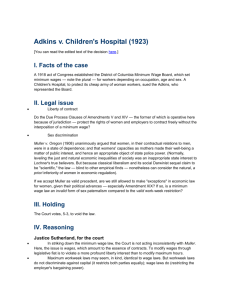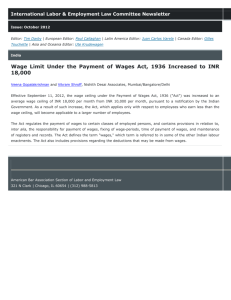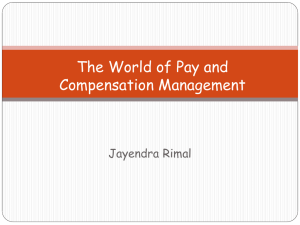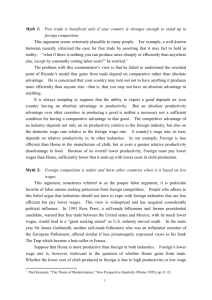Lecture 05
advertisement
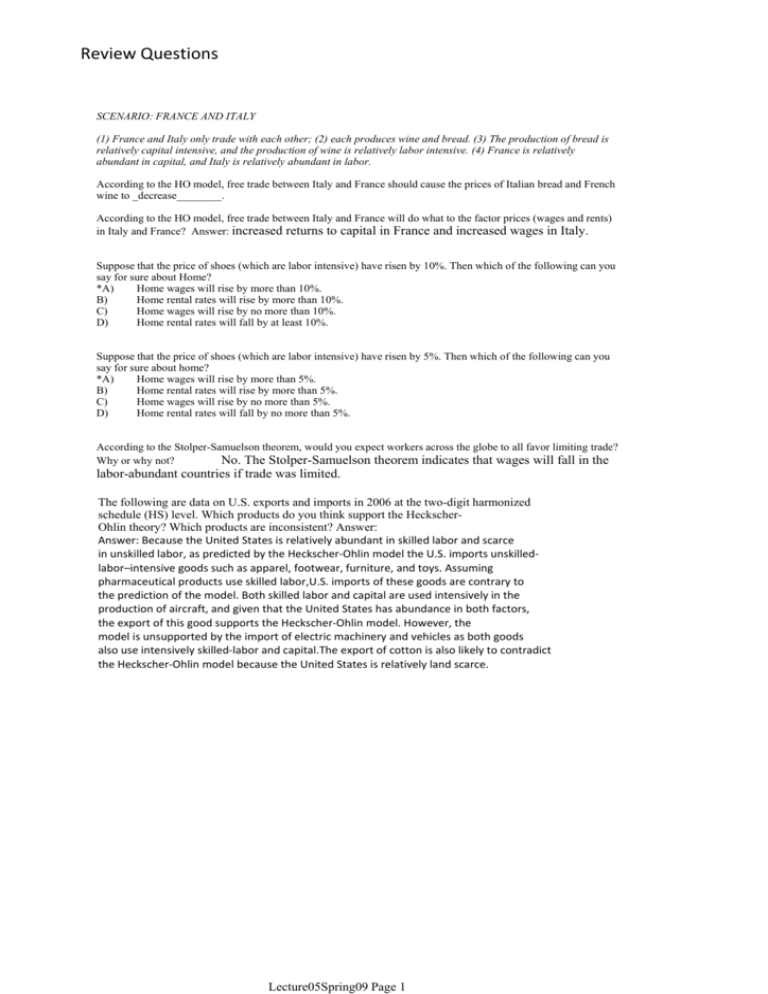
Review Questions SCENARIO: FRANCE AND ITALY (1) France and Italy only trade with each other; (2) each produces wine and bread. (3) The production of bread is relatively capital intensive, and the production of wine is relatively labor intensive. (4) France is relatively abundant in capital, and Italy is relatively abundant in labor. According to the HO model, free trade between Italy and France should cause the prices of Italian bread and French wine to _decrease________. According to the HO model, free trade between Italy and France will do what to the factor prices (wages and rents) in Italy and France? Answer: increased returns to capital in France and increased wages in Italy. Suppose that the price of shoes (which are labor intensive) have risen by 10%. Then which of the following can you say for sure about Home? *A) Home wages will rise by more than 10%. B) Home rental rates will rise by more than 10%. C) Home wages will rise by no more than 10%. D) Home rental rates will fall by at least 10%. Suppose that the price of shoes (which are labor intensive) have risen by 5%. Then which of the following can you say for sure about home? *A) Home wages will rise by more than 5%. B) Home rental rates will rise by more than 5%. C) Home wages will rise by no more than 5%. D) Home rental rates will fall by no more than 5%. According to the Stolper-Samuelson theorem, would you expect workers across the globe to all favor limiting trade? No. The Stolper-Samuelson theorem indicates that wages will fall in the Why or why not? labor-abundant countries if trade was limited. The following are data on U.S. exports and imports in 2006 at the two-digit harmonized schedule (HS) level. Which products do you think support the HeckscherOhlin theory? Which products are inconsistent? Answer: Answer: Because the United States is relatively abundant in skilled labor and scarce in unskilled labor, as predicted by the Heckscher‐Ohlin model the U.S. imports unskilled‐ labor–intensive goods such as apparel, footwear, furniture, and toys. Assuming pharmaceutical products use skilled labor,U.S. imports of these goods are contrary to the prediction of the model. Both skilled labor and capital are used intensively in the production of aircraft, and given that the United States has abundance in both factors, the export of this good supports the Heckscher‐Ohlin model. However, the model is unsupported by the import of electric machinery and vehicles as both goods also use intensively skilled‐labor and capital.The export of cotton is also likely to contradict the Heckscher‐Ohlin model because the United States is relatively land scarce. Lecture05Spring09 Page 1 Lecture05Spring09 Page 2 Last times… A short run and Long run model of Trade Two countries: Denmark and Finland Two industries: Agriculture and Manufacturing) World Prices: PA, PM y A K A LA1 yM K M LM 1 Endowments: LA LM LD K A KM KD Short Run Specific Factors Model: KA and KM are fixed Long Run Heckscher Ohlin: KA and KM are mobile and perfectly substitutable Chapters 3 and 4: What happens when final goods are allowed to move freely? Chapter 5: What happens when factors are allowed to move freely? Lecture05Spring09 Page 3 Migration in the Short Run Denmark: PMMPLM LA PAMPLA LM LA Finland: PAMPLA PAMPLA PMMPLM LA LA LM Lecture05Spring09 Page 4 PAMPLA Gains and Losses from Immigration Wages in each country are decreasing functions of labor endowments Danish wage Finnish wage LD Define: Danish wage LF LD LF LW Finnish wage LF LD Lecture05Spring09 Page 5 FDI in the short run: Denmark relocates a Lego Factory to Finland Denmark: PMMPLM LA PAMPLA LM Lecture05Spring09 Page 6 Finland: PAMPLA PMMPLM LA LM Lecture05Spring09 Page 7 Gains and Losses from FDI Capital rents in each country are decreasing functions of fixed capital endowments Finnish rent Danish rent KM,F KM,D Danish rent Finnish rent KM,F KM,D Lecture05Spring09 Page 8 The Long Run: Factor Price Insensitivity y A K A LA1 yM K M LM 1 Factor prices: Unit factor requirements aLA unit labor requirement in Agriculture Lecture05Spring09 Page 9 Factor Price Insensitivity: In the HO model, with constant returns to scale, free mobility of factors, and world market final good prices, factor prices and factor intensities are not determined by (insensitive to) factor endowments! Lecture05Spring09 Page 10 The Box Diagram KA LA KM LM Lecture05Spring09 Page 11 Lecture05Spring09 Page 12 Factor movements: The Long Run Lecture05Spring09 Page 13 Lecture05Spring09 Page 14 Rybczynski Theorem An increase in the endowment of a factor results in a bigger increase in the output of the industry intensive in that factor. The other industry's output decreases as a results. Lecture05Spring09 Page 15 Review Questions When factors of production are not fixed (as per the long run) and labor immigrates, capital will: A) remain fixed because capital is never mobile. B) increase in the capital‐intensive industry. C) move to the higher productivity use in the labor‐intensive industry until returns are again equalized. D) become idled as owners of capital seek more profitable opportunities. In the long run (the HO model), immigration will lead to: A) an increase in the wage and a decrease in the return to capital in the receiving country. B) an increase in both the wage and the return to capital in the receiving country. C) a decrease in the wage and an increase in the return to capital in the receiving country. D) no change in the wage and the return to capital in the receiving country. For the sending country, what will be the long‐run effects of immigration on wages and the return to capital? A) The wage will increase, and the return to capital will decrease. B) The wage will decrease, and the return to capital will increase. C) Both the wage and the return to capital will increase. D) There will be no change in the wage and the return to capital. During the past 10 to 20 years, a considerable amount of foreign capital has flowed into China. What is an implication of capital flow upon the composition of Chinese trade? A) There should be no change in the composition of China's trade. B) There should be a shift toward the export of more labor‐intensive products. C) There should be a shift toward the export of more capital‐intensive products. D) There should be a shift toward the import of more capital‐intensive products. Owners of capital and labor usually support the reduction of restrictions on immigration. A) True B) False In the long run, the output of the capital‐intensive good will increase if the amount of capital increases in a country due to FDI. A) True B) False Lecture05Spring09 Page 16





